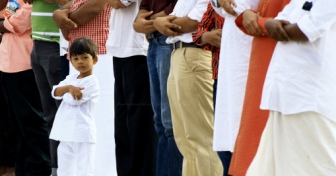The Great Divide: a Sunni perspective
The division between Sunnis and Shias is nearly as old as Islam itself. Although the two main branches of Islam share most of their beliefs and practices, political and theological divisions have become much more prominent in recent years. Events like the war in Syria and sectarian violence in Iraq and Pakistan have polarized the two communities, even in the UK.
In conversation with Egyptian journalist Shaimaa Khalil, Cambridge Islam scholar Tim Winter (better known to many Muslims as Abdal Hakim Murad) provides a Sunni perspective on how the division began and what it consists in today.
He explains how different groups started to go their separate ways over the question of who should succeed the Prophet Muhammad, and provides a Sunni critique of the Shia way of commemorating the event which has become a cornerstone of Shia identity: the killing of the Prophet’s grandson Hussain in Kerbala in what is now Iraq.
And, despite the deep political rift between the Sunni and Shia power blocks in the Middle East today, he shows that the differences in worship and practice are far smaller than those between some Christian denominations.
Listen to the second part to this podcast, The Great Divide – a Shia perspective, featuring Shia researcher and lecturer Mohammed al-Hilli here.
Image courtesy of Manu Manohar via flickr.com ©©



Latest comments
Leave a comment
It is a mistake to contend that the Prophet (pbuh) did not leave instructions regarding succession. He clearly did, naming Imam Ali as his successor before a huge crowd, only some important people chose to deny it.
It is a mistake to contend that the so called Caliphate was established through popular consent; far from it. As a matter of fact the first three Caliphs were each chosen by three different methods; only Imam Ali was chosen by popular demand. As for the tragedy of Karbala, its seeds were, indeed, sown at the inception of the first Caliphate.
Yazid, to whom reigns of power were transferred by his father, cannot even be counted a Muslim. Yet he professed to be the head of the then Muslim state, forcing all Muslims to swear to his allegiance or, else, face elimination. Forced, Imam Hussain refused to submit to this demand. To stage an uprising was not his mission.
N Hasnain
N Hasnain
Interesting but highly biased and full of knowledge and factual gaps. The divide started not with the Caliphate issue, after the Prophet’s passing away, which remained a benign factor. Some background about Ali. He was the Prophet’s first cousin and later his son in law and adopted by the Prophet when he was 8 or 9 year old when Ali’s father, Abu Talib, was unable to maintain his large brood. Ali continued to live with the Prophet, ultimately marrying his daughter Fatima, and was the person who buried The Prophet, while the others, Abu Bakr, Umar etc were busy selecting the next leader. It is generally accepted that he lived with the prophet in the same house from age 8 to about 34 or 35, a period of about 26 years. Hence he had the closest access to the Prophet and also the most insight about Islam and its practices, second only after the Prophet. The real split happened as a result of two battles much before Karbala and when Ali became Calip, after Caliph Usman.. The first is the Battle of Jamal or the Battle of the Camel, between Ali, and the Prophet’s wife Aisha, goaded and supported by Muawiyya, under the garb of avenging the death of Caliph Usman, which had nothing to do with Ali, knowing Aisha’s not very favourable view of Ali and his wife Fatima and to use her position and influence as the wife of the Prophet to take back the lost power of the Quraysh merchant’s of Mecca. Muawiya was then the Governor of Syria, and son of Abu Sufyaan, the Prophet’s arch enemy and foe, the leader of the Quraysh merchants and only converted to Islam after the conquest of Mecca. The second was between Ali and Muawiyya called the Battle of Siffin, in which Muawiyya again tried to vest the Caliphate from Ali. This was really the start of the political divide, and the subsequen theological divide between the two sects was each trying to present its version of the Prophet’s sunnah as the “correct one”. Sunni Islam and its version of the Prophetic Sunnah reigned supreme because for the subsequent 300 years the Caliphs were all Sunnis. two excellent books on the subject are Leslie Hazelton’s ” After the Prophet” and Barnaby Rogerson’s ” The Heirs of the Prophet Muhammad”…both are highly researched, unbiased commentaries on the issue, and especially useful as they are objective narrations written by non-muslims, with no bias towards Sunnis or Shias.
haider mehdi
Seriously Mr.Murad. Prophet did not leave a form of political ideology. Why don’t you read about Ghadir. you are based in Cambridge, It is easy for you to research.
If one gets to know about Ghadir he could then see the picture more clearly and the pieces that come after the Death of the prophet could easily be joined.
Muhammad Murad
A very thoughtful debate, thank you. I am looking forward to hear the shia perspective soon.
Majid